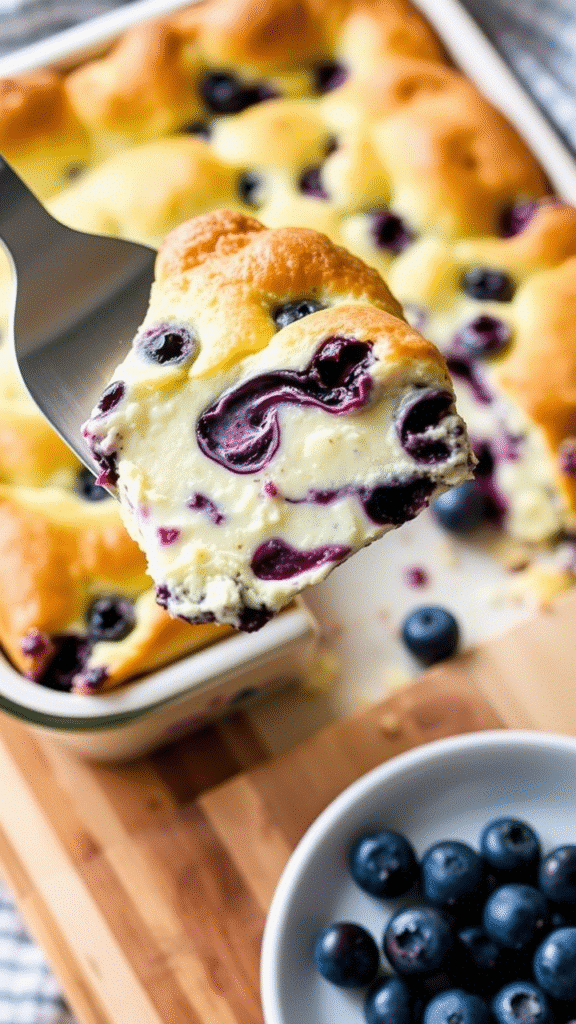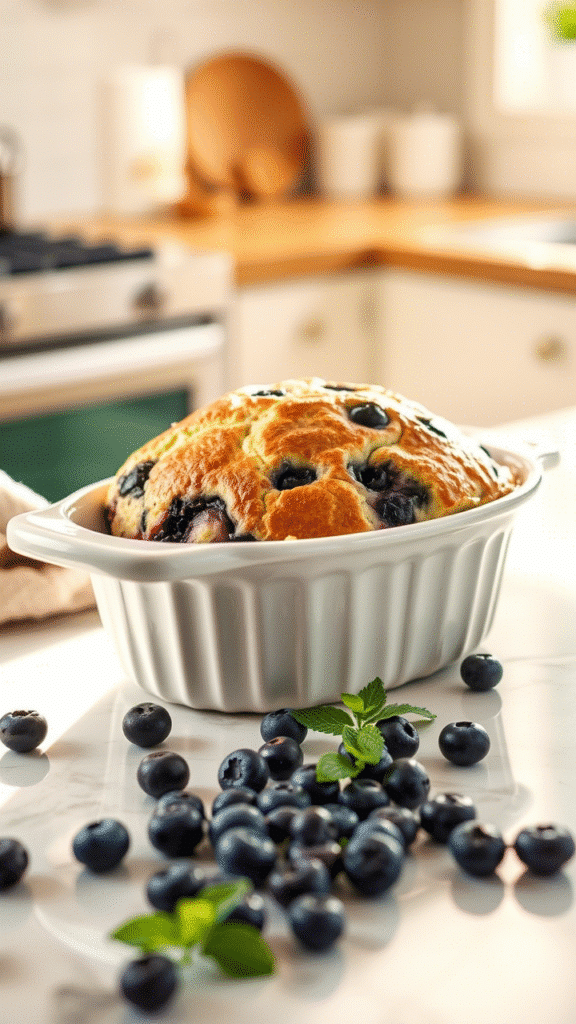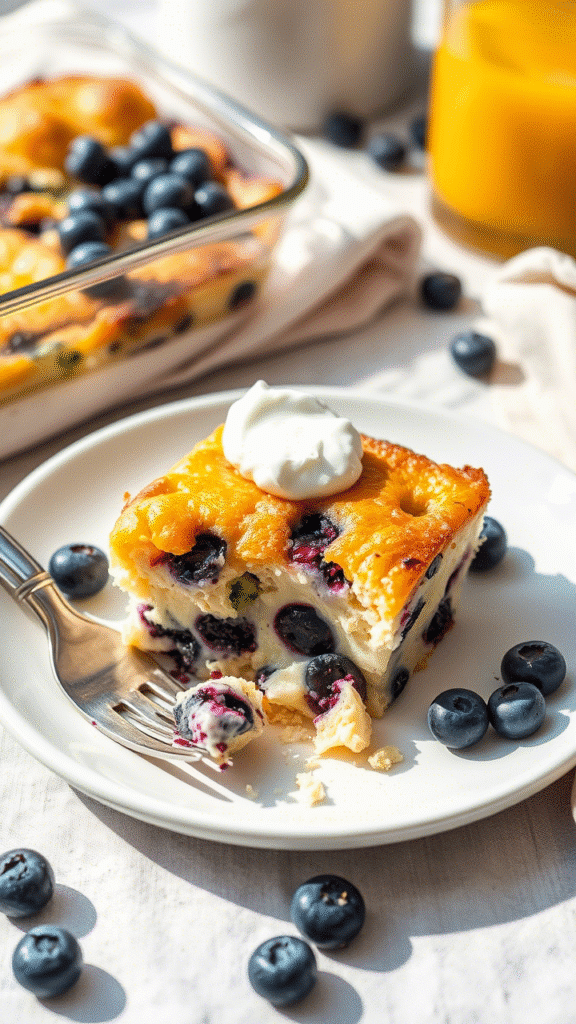Three years ago, I watched a seasoned chef at a boutique inn in Vermont serve what looked like an ordinary breakfast casserole to a table of food critics. Within minutes, they were asking for the recipe. The secret wasn’t in some exotic ingredient or complicated technique it was cottage cheese, transformed into something extraordinary through proper understanding of protein coagulation and moisture management.
This wasn’t your grandmother’s cottage cheese pancake or the mushy breakfast bakes that haunt hotel buffets. This was architecture on a plate: structured, elegant, and impossibly satisfying.
What Makes This Breakfast Bake Special
The Blueberry Cottage Cheese Breakfast Bake represents a masterclass in protein chemistry and fruit integration. Unlike traditional egg-heavy casseroles that can turn rubbery, this dish leverages cottage cheese’s unique protein structure to create a custard-like interior with a golden, slightly firm exterior. The blueberries aren’t just mixed in they’re strategically distributed to create pockets of tartness that balance the mild, creamy base.
Most breakfast bakes suffer from what I call “soggy bottom syndrome” that unpleasant layer where moisture collects and creates an unappetizing texture. This recipe eliminates that problem through proper layering techniques and understanding how cottage cheese behaves under heat.
The dish bridges the gap between healthy and indulgent, offering substantial protein content while maintaining the comfort-food appeal that makes breakfast special.
Ingredients & Substitutions
Base Layer:
- 32 oz (4 cups) whole milk cottage cheese, large curd preferred
- 6 large eggs, room temperature
- 1/3 cup pure maple syrup
- 2 tablespoons vanilla extract
- 1/2 teaspoon kosher salt
- 1/4 cup all-purpose flour
Fruit Component:
- 2 cups fresh blueberries (or 1 3/4 cups frozen, thawed and drained)
- 1 tablespoon cornstarch
- 1 tablespoon lemon juice
- 1 teaspoon lemon zest
Topping:
- 1/2 cup rolled oats
- 1/4 cup sliced almonds
- 2 tablespoons brown sugar
- 2 tablespoons cold butter, diced
- 1/4 teaspoon cinnamon
The cottage cheese selection is crucial large curd varieties provide better texture contrast than small curd versions. If you’re working with small curd, increase the flour by one tablespoon to compensate for the higher moisture content. For those avoiding dairy, thick Greek yogurt can substitute for cottage cheese, though you’ll need to drain it overnight to achieve similar consistency.
Room temperature eggs integrate more smoothly and prevent the cottage cheese from seizing up. Cold eggs can cause the mixture to become grainy, a common mistake that ruins the final texture.
Pure maple syrup offers complexity that regular syrup can’t match, but if you must substitute, use honey reduced by one tablespoon since it’s sweeter. The vanilla extract should be real imitation vanilla creates an artificial aftertaste that becomes more pronounced when heated.
Fresh blueberries are ideal, but frozen work well if properly thawed and drained. Pat them dry with paper towels to remove excess moisture. The cornstarch coating prevents the berries from sinking and helps them maintain their shape during baking.
Step-by-Step Instructions

Preparation Phase:
Preheat your oven to 350°F (175°C). This moderate temperature ensures even cooking without overcooking the exterior before the interior sets. Grease a 9×13 inch baking dish with butter spray creates an uneven surface that can cause sticking.
Creating the Base:
In a large mixing bowl, whisk the eggs until they’re just combined. Don’t overbeat you want incorporation, not aeration. Add the cottage cheese in three additions, whisking gently between each. This gradual combination prevents lumps and creates a smoother texture.
Stir in maple syrup, vanilla, and salt. The mixture should look slightly lumpy but cohesive. Add flour and fold until just incorporated. Overmixing develops gluten, creating a tough final product.
Fruit Preparation:
In a separate bowl, toss blueberries with cornstarch, lemon juice, and zest. The cornstarch serves double duty: it prevents sinking and absorbs excess juice that could make the bake watery. The lemon brightens the berries’ flavor and helps maintain their color during baking.
Let this mixture sit for five minutes. You’ll notice the berries beginning to release juice, which the cornstarch will absorb.
Assembly:
Pour the cottage cheese mixture into your prepared baking dish. Distribute the blueberry mixture evenly across the surface, pressing them gently into the mixture but not completely submerging them. This partial submersion creates the perfect distribution pattern.
Creating the Topping:
Mix oats, almonds, brown sugar, and cinnamon in a small bowl. Add cold butter pieces and work them in with your fingers until the mixture resembles coarse crumbs. This streusel-like topping provides textural contrast and prevents the surface from becoming monotonous.
Sprinkle the topping evenly over the blueberries. Don’t pack it down you want it loose enough to crisp properly.
Baking Process:
Bake for 45-50 minutes, until the center is set but still slightly jiggly when gently shaken. The top should be golden brown and the edges should be pulling slightly away from the sides. An instant-read thermometer inserted in the center should read 160°F (71°C).
Common mistake: overbaking creates a tough, rubbery texture. The residual heat will continue cooking the center even after removal from the oven.
Cooling and Serving:
Allow the bake to cool for at least 15 minutes before serving. This cooling period allows the proteins to fully set and makes cutting much easier. The texture will firm up considerably during this time.
Cooking Techniques & Science
The magic of this dish lies in understanding protein coagulation. Cottage cheese contains casein proteins that behave differently from the albumin proteins in eggs. When heated gently, these proteins form a stable gel network that traps moisture while maintaining a creamy texture.

The moderate oven temperature is crucial because cottage cheese proteins are more sensitive to heat than egg proteins. Too high heat causes them to contract rapidly, expelling moisture and creating a grainy, tough texture. The 350°F temperature allows gradual coagulation while preserving the characteristic cottage cheese texture.
The flour serves as a binding agent and helps absorb excess moisture. It also provides structure without overwhelming the delicate cottage cheese flavor. Too much flour creates a dense, cake-like texture; too little results in a loose, pudding-like consistency.
Blueberry distribution requires understanding fruit behavior under heat. Fresh blueberries release juice as they cook, which can create soggy spots if not properly managed. The cornstarch coating creates a barrier that controls moisture release while helping the berries maintain their shape.
The streusel topping creates a Maillard reaction on the surface, developing complex flavors and providing textural contrast. The oats add fiber and nutty flavor, while the almonds contribute healthy fats and crunch.
Serving & Pairing Suggestions
Presentation:
Cut into neat squares using a sharp knife wiped clean between cuts. The clean cuts showcase the beautiful purple-blue swirls created by the blueberries. Serve on warmed plates to maintain temperature longer.
A light dusting of powdered sugar adds visual appeal, but taste first the maple syrup might provide sufficient sweetness. A small sprig of fresh mint creates an elegant garnish that complements the blueberries’ flavor.
Complementary Pairings:
This breakfast bake pairs beautifully with crispy bacon or turkey sausage the salty, savory elements balance the dish’s natural sweetness. For a lighter option, serve alongside fresh fruit salad or Greek yogurt drizzled with honey.
Coffee is the obvious beverage choice, but consider offering fresh orange juice or herbal tea. The citrus in orange juice enhances the blueberries’ flavor, while chamomile tea provides a soothing contrast to the rich, protein-heavy dish.
For brunch service, consider offering multiple temperature options. This dish is delicious warm, at room temperature, or even slightly chilled. Each temperature highlights different flavor aspects.
Professional Service Tips:
In commercial settings, this bake holds well in warming drawers set to 140°F (60°C) for up to two hours without quality degradation. For buffet service, cut into individual portions and arrange on a heated serving tray to maintain temperature and presentation standards.
The recipe scales well for larger operations. Double recipes work perfectly in hotel pans, though baking time may need adjustment. Always use a thermometer to ensure proper doneness rather than relying solely on visual cues.
Advanced Variations and Techniques
Seasonal Adaptations:
Summer: Substitute peaches or mixed berries for different flavor profiles. Stone fruits require less cornstarch due to their lower moisture content.
Fall: Apple and cinnamon versions work beautifully. Dice apples small and toss with extra cinnamon and a pinch of nutmeg.
Winter: Dried cranberries soaked in warm orange juice create a festive variation. The orange juice adds citrus notes while rehydrating the cranberries.
Dietary Modifications:
For gluten-free versions, substitute almond flour for all-purpose flour. Use slightly less about 3 tablespoons as almond flour is more absorbent.
Lower-fat versions can use 2% cottage cheese, but increase the flour slightly to compensate for the higher moisture content. The texture will be less rich but still satisfying.
Professional Scaling:
This recipe works well for catering operations. For 50 servings, use hotel pans and increase baking time to 60-70 minutes. The larger volume requires longer cooking time for the center to reach proper temperature.
Individual ramekin portions create elegant presentations for high-end brunch services. Reduce baking time to 25-30 minutes for 6-ounce portions.
Troubleshooting Common Issues

Watery Texture:
Usually caused by insufficient drainage of thawed frozen berries or using cottage cheese with excessive whey. Always drain berries thoroughly and consider straining cottage cheese if it seems particularly liquid.
Grainy Consistency:
Results from adding cold eggs to cottage cheese or overmixing. Always use room temperature eggs and mix just until combined.
Uneven Cooking:
Indicates oven hot spots or improper placement. Use the center rack and rotate the pan halfway through baking if your oven has known hot spots.
Burnt Topping:
The streusel browns quickly due to the brown sugar content. If the topping browns too fast, tent with foil during the last 15 minutes of baking.
Storage and Reheating
Refrigeration:
Store covered in the refrigerator for up to four days. The texture actually improves after the first day as flavors meld and the structure settles.
Freezing:
This dish freezes well for up to three months. Wrap individual portions in plastic wrap, then aluminum foil for best results. Thaw overnight in the refrigerator before reheating.
Reheating:
For best results, reheat in a 325°F oven for 15-20 minutes until warmed through. Microwave reheating works but can create uneven heating and affect texture.
The Professional Edge
Understanding this recipe’s fundamentals allows for creative adaptation while maintaining structural integrity. The protein-starch-fruit balance can be applied to numerous variations, making it a valuable addition to any professional breakfast repertoire.
The dish’s make-ahead capability makes it invaluable for busy kitchens. Assemble the night before and bake fresh in the morning for optimal service timing. This advance preparation actually improves flavor development as ingredients have time to meld.
For operations focused on health-conscious offerings, this bake provides substantial protein (approximately 15 grams per serving) while maintaining the comfort-food appeal that drives customer satisfaction. The cottage cheese provides probiotics, while blueberries offer antioxidants compelling selling points for health-aware consumers.
The visual appeal cannot be understated. The purple-blue swirls against the creamy white background create Instagram-worthy presentations that drive social media engagement. In today’s food service environment, dishes must photograph as well as they taste.
Conclusion
The Blueberry Cottage Cheese Breakfast Bake represents everything modern food service demands: nutritional value, visual appeal, operational efficiency, and exceptional taste. It’s a dish that works equally well in a boutique inn’s intimate dining room or a hotel’s expansive breakfast buffet.
The key to mastering this recipe lies in understanding the science behind the ingredients. Cottage cheese isn’t just a protein source it’s a textural foundation that, when properly handled, creates something extraordinary. The blueberries aren’t mere additions they’re integral components that must be properly managed to achieve the desired result.
Professional success with this dish comes from respecting the process. Don’t rush the cooling period. Don’t overmix the base. Don’t skip the cornstarch coating on the berries. These seemingly small details make the difference between mediocre and memorable.
Most importantly, taste as you go. Adjust sweetness based on your berries’ natural sugar content. Consider your audience a health-conscious crowd might appreciate less maple syrup, while a comfort-food focused service might benefit from a touch more vanilla.
This recipe will become a cornerstone of your breakfast offerings, not because it’s complicated or exotic, but because it’s thoughtfully constructed and flawlessly executed. That’s the hallmark of professional cooking taking simple ingredients and creating something transcendent through technique and understanding.
Frequently Asked Questions?
Can I prepare this dish the night before?
Absolutely, and it’s actually recommended for busy service periods. Assemble the entire dish, cover tightly with plastic wrap, and refrigerate overnight. Remove from refrigeration 30 minutes before baking to allow it to come closer to room temperature, then bake as directed. You may need to add 5-10 minutes to the baking time since you’re starting with a cold dish.
What’s the best way to prevent the blueberries from sinking to the bottom?
The cornstarch coating is your first line of defense, but there’s a professional trick: dust the berries with a small amount of flour before adding the cornstarch mixture. This creates an even more effective barrier. Also, don’t overmix once you add the berries gentle folding maintains their distribution throughout the mixture.
Can I substitute Greek yogurt for cottage cheese?
Yes, but with important modifications. Use thick, full-fat Greek yogurt and drain it overnight through cheesecloth to remove excess whey. You’ll need about 3 cups of drained yogurt to replace 4 cups of cottage cheese. The texture will be slightly denser but still delicious. Increase the flour to 1/3 cup to help bind the extra moisture.
How do I know when it’s perfectly done?
The center should be set but still have a slight jiggle when you gently shake the pan think of a perfectly cooked cheesecake. An instant-read thermometer inserted in the center should read 160°F (71°C). The edges will pull slightly away from the sides, and the top will be golden brown. If you’re unsure, it’s better to slightly underbake than overbake, as residual heat will continue cooking the center.
What’s the best way to reheat individual portions for service?
For restaurant service, individual portions reheat beautifully in a 325°F oven for 12-15 minutes. Cover with foil to prevent the top from over-browning. For faster service, microwave on 50% power for 2-3 minutes, which heats more evenly than full power. The key is gentle reheating to preserve the delicate texture of the cottage cheese proteins.

Veronica is a passionate food enthusiast with over three years of experience in exploring and writing about diverse cuisines. Her expertise lies in reviewing restaurants, sharing creative recipes, and discovering the latest food trends. As the voice behind FoodieRecap.com, Anju brings fresh perspectives and culinary insights to her audience.
